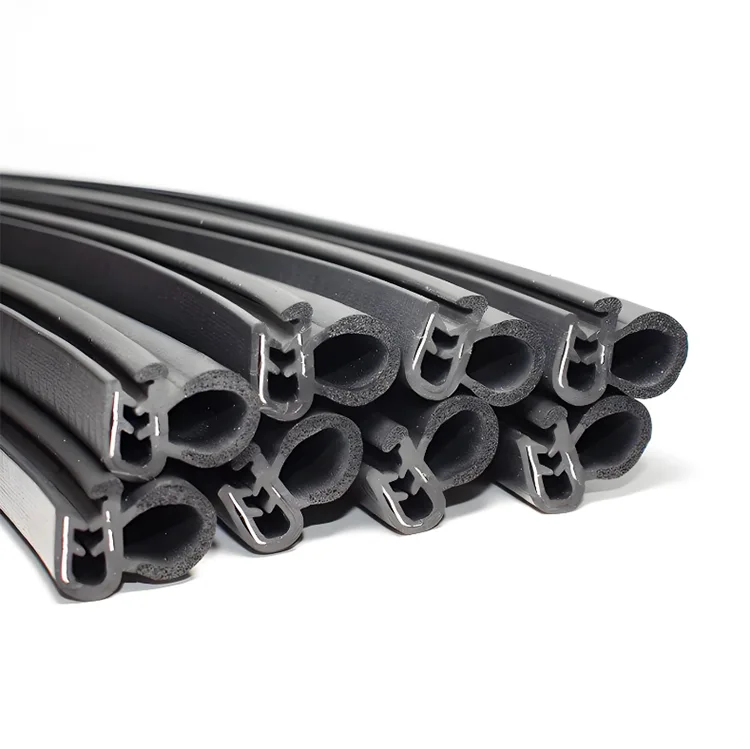1. Introduction
When I talk about automotive rubber sealing strips with metal frames, I’m referring to a specialized class of sealing components that combine flexible elastomer sections with rigid or semi-rigid metal carriers. These seals are engineered to grip tightly onto vehicle body flanges while providing a continuous barrier against external elements. The metal frame inside acts as a skeleton, giving the seal both strength and shape retention, even around complex curves or high-stress points.
In the automotive world, these sealing strips play an essential role in both comfort and protection. They prevent rainwater, dust, and wind from entering the cabin, reduce road noise, and help maintain the vehicle’s energy efficiency by preserving interior climate control. Beyond that, they contribute to the car’s long-term durability by protecting metal body edges from corrosion and wear.
You can find these metal-reinforced seals in several areas of a vehicle: around doors, trunks, hoods, sunroofs, and sliding doors, as well as along window channels where they guide and cushion the glass. Their versatility and performance make them a go-to choice for automotive manufacturers and aftermarket suppliers seeking reliable, long-lasting sealing solutions.
2. Structure and Components
From my experience in designing and supplying automotive sealing solutions, a metal-framed rubber seal is more than just a strip of rubber. It’s a precisely engineered assembly where each component serves a specific purpose, ensuring the seal performs reliably under various operating conditions.
Rubber/Elastomer Section
The visible portion of the seal is usually made from high-performance elastomers. The most common is EPDM (Ethylene Propylene Diene Monomer), prized for its excellent weather resistance, UV stability, and flexibility across a wide temperature range. Other materials like TPV (Thermoplastic Vulcanizate) offer recyclability and design flexibility, while silicone excels in extreme temperature applications, and NBR blends provide good oil resistance for specific environments.
Depending on the sealing requirement, the rubber section can be solid for maximum durability or sponge/foam for better compression and cushioning. In many cases, a combination of both is used in a single profile for optimal sealing and fit.
Metal Frame/Carrier
Embedded inside the rubber is a metal carrier, which gives the seal its structural strength and allows it to clamp securely to a body flange. Steel is the most common choice due to its balance of strength and cost, while stainless steel offers corrosion resistance in harsh climates, and aluminum provides a lightweight alternative. The carrier can feature serrations or clip-style teeth that grip the flange firmly without additional adhesives, ensuring stability even under vibration and repeated use.
Optional Layers
For specific functions, extra layers are applied:
- Flocking (a velvety coating) is often added to glass-run channels to reduce friction and noise as windows move.
- Adhesive strips or double-sided tapes can be integrated to improve initial retention during installation, especially in areas with complex shapes or high tension.
This combination of elastomer flexibility, metal strength, and optional enhancements is what makes these sealing strips reliable and long-lasting in demanding automotive environments.
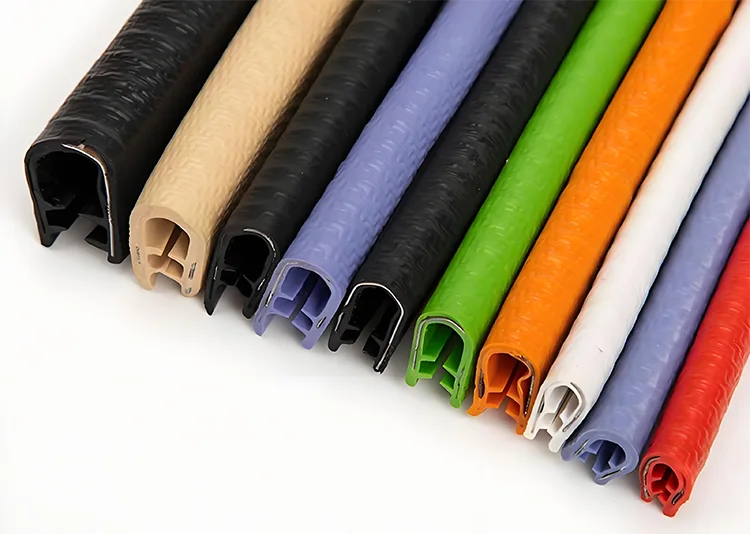
3. Types of Metal-Reinforced Seals
Over the years, I’ve seen how metal-framed rubber sealing strips adapt to a wide variety of vehicle designs. Their versatility comes from the fact that they can be extruded and shaped into profiles that meet specific sealing needs. Here are some of the most common types used in automotive applications:
U-Channel Edge Trims with Bulb Seals
This is perhaps the most recognizable form—an internal metal-reinforced U-shaped channel grips the body flange, while a bulb-shaped hollow rubber section compresses to create the seal. These are widely used on door edges, hoods, and trunks to block water, dust, and wind. The metal core ensures the channel holds firmly, even around curves.
Glass-Run Channels for Windows
These seals are designed to line the inner edges of window frames, guiding and cushioning the glass as it moves up and down. The metal frame keeps the channel perfectly aligned, while flocked rubber surfaces minimize friction and noise. They are critical in ensuring smooth window operation and preventing rattling.
Weatherstrips for Doors, Trunks, Hoods, and Sunroofs
Full-perimeter weatherstrips are used to seal movable parts like doors and sunroofs. The embedded metal frame ensures these long seals maintain consistent compression all around, preventing leaks and reducing wind noise.
Specialized Seals for Sliding Doors or Panoramic Roofs
For vehicles with sliding mechanisms or large glass panels, specialized seals are designed to follow complex tracks and curves. The metal carrier allows the seal to be both flexible enough for movement and rigid enough to maintain sealing pressure.
By tailoring the profile design and materials, each of these types can meet the unique challenges of different areas of the vehicle, ensuring a perfect balance of sealing performance, durability, and ease of installation.
4. Key Functions
When I specify or design automotive rubber sealing strips with metal frames, I focus on more than just their physical shape—they have to perform a set of critical functions that directly impact vehicle comfort, safety, and longevity.
Retention and Grip on Body Flanges
The embedded metal carrier provides a firm, lasting grip on the vehicle’s body flanges. Whether the car is in daily city use or exposed to rough, off-road vibration, the seal must remain securely in place without loosening or shifting over time.
Weather Sealing (Water, Dust, Wind)
One of the main purposes of these seals is to create a continuous barrier against environmental elements. By blocking rainwater, road dust, and air drafts, they help protect the vehicle’s interior and maintain its structural integrity.
Noise, Vibration, and Harshness (NVH) Reduction
Properly engineered seals act as an effective barrier against road noise and vibration. By damping the contact between moving parts and the body structure, they help create a quieter, more comfortable cabin environment.
Aesthetic Finishing for Vehicle Edges
These seals are often visible along doors, hoods, and window frames. A well-designed sealing strip not only performs mechanically but also provides a clean, finished appearance that enhances the vehicle’s overall look.
Controlled Compression for Sealing Performance
The bulb or sponge section of the seal must compress within a specific range—too little and it won’t seal, too much and it may wear prematurely or cause door/window misalignment. The metal frame ensures that this compression is consistent along the entire length of the seal, even on curved or angled surfaces.
In short, these seals are not passive components—they are active contributors to the vehicle’s comfort, efficiency, and long-term durability.
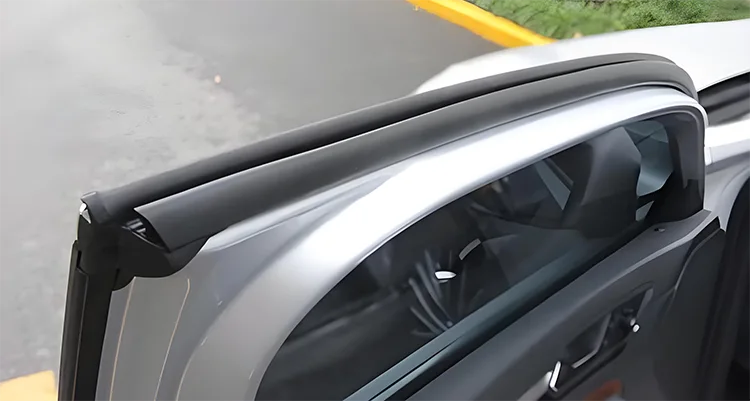
5. Materials and Standards
In my work with automotive sealing systems, I’ve found that choosing the right materials and adhering to industry standards is the foundation for long-lasting, reliable seals. Metal-framed rubber sealing strips must meet stringent requirements for performance, safety, and durability.
Rubber Materials
- EPDM (Ethylene Propylene Diene Monomer) is the industry’s go-to elastomer for weatherstrips because of its outstanding resistance to ozone, UV radiation, and extreme temperatures (typically from –40°C to +120°C). It maintains flexibility over time and doesn’t crack under prolonged exposure to sunlight or moisture.
- TPV (Thermoplastic Vulcanizate) is a recyclable alternative with good weather resistance and process flexibility, making it suitable for complex profiles.
- Silicone Rubber offers superior thermal stability (up to +200°C) and remains flexible in freezing conditions, making it ideal for specialty applications like engine bay seals.
- NBR (Nitrile Butadiene Rubber) Blends are chosen when oil or fuel resistance is required, although they have lower weathering resistance compared to EPDM.
Applicable Standards
- SAE J200 / ASTM D2000: These standards define classification systems for solid rubber materials, specifying physical properties like tensile strength, hardness, and heat aging resistance based on application needs (SAE International, ASTM International).
- ASTM D1056: Covers the classification of flexible cellular (sponge) rubber, detailing grades for compression deflection, water absorption, and other key performance factors (ASTM International).
- FMVSS 302 / ISO 3795: These flammability standards require that materials used in vehicle interiors burn at a controlled rate or self-extinguish to meet passenger safety requirements (NHTSA FMVSS 302 Overview, ISO Standards).
By aligning with these globally recognized specifications, I ensure that every sealing strip we produce not only fits perfectly but also performs consistently over the vehicle’s lifetime. These standards act as a guarantee to buyers and manufacturers that the product meets rigorous engineering, safety, and environmental benchmarks.
6. Manufacturing and Assembly
Producing automotive rubber sealing strips with metal frames is a precision-driven process where each step impacts the final performance. From my perspective, understanding the manufacturing sequence is crucial for ensuring consistent quality and fit.
Co-Extrusion of Rubber and Carrier
The process begins with co-extrusion, where the elastomeric section (solid, sponge, or a combination) is extruded while the metal carrier is simultaneously fed into the die. This allows the rubber to form securely around the metal, locking it in place without compromising flexibility.
Embedding the Metal Carrier During Forming
The metal carrier, usually pre-notched or perforated, is designed to bend easily around curves while maintaining grip. By embedding it during extrusion, we ensure the seal has built-in structural reinforcement that follows the vehicle’s contours without warping.
Flocking and Surface Treatments
For seals used in glass-run channels, a flocking process applies a fine layer of nylon or polyester fibers to the rubber surface. This reduces friction, minimizes noise during window operation, and prevents glass scratching. In other cases, low-friction coatings or painted finishes are applied for durability and aesthetics.
Molded Corners and Spliced Joints
In areas with tight radii or complex shapes, molded corner sections are produced separately and joined to straight extrusions via hot splicing or vulcanized bonding. This ensures seamless transitions without leakage points.
Final Assembly and Quality Checks
After extrusion and finishing, the strips are cut to length, shaped, and prepared for installation. Quality control includes dimensional checks, adhesion testing between rubber and metal, and visual inspections to ensure the flocking or coating is uniform.
This multi-stage manufacturing approach ensures that every sealing strip fits precisely, grips securely, and withstands years of use without losing performance.
7. Design Considerations
When I work on specifying or developing automotive rubber sealing strips with metal frames, I focus heavily on design parameters. These determine not only how well the seal functions on day one but also how it performs years down the road.
Correct Flange Thickness Range
Every seal profile is designed for a specific flange thickness tolerance. If the flange is too thin, the grip may be weak; too thick, and installation becomes difficult, risking deformation of the seal or damage to the metal carrier.
Bulb Compression Percentage
For optimum sealing, the bulb or sponge section should compress within 30–50% of its original height. This range ensures enough pressure to block water and wind without causing premature material fatigue or making doors/windows hard to close.
Minimum Bend Radius for Carriers
The embedded metal carrier must be able to bend smoothly around corners without kinking. Each carrier profile has a minimum bend radius, and exceeding this can cause stress points, leading to eventual cracking or detachment.
Corrosion Prevention for Metal Parts
Since the carrier is often steel, it’s essential to apply galvanization, stainless steel selection, or protective coatings to prevent rust—especially in high-humidity or salt-rich environments. This is particularly important for vehicles used in coastal areas or regions where roads are salted in winter.
Friction Management for Moving Parts
In applications where glass or sliding doors move along the seal, low-friction flocking or coatings reduce operational resistance, minimize wear, and prevent squeaks. This not only improves user comfort but also extends seal life.
Balancing these design details is critical. A seal that fits perfectly, compresses properly, and resists environmental challenges will offer the long-term retention, sealing performance, and aesthetics that automotive manufacturers demand.
8. Installation and Maintenance
In most cases, automotive rubber sealing strips with metal frames are installed following detailed OEM or supplier guidelines. The process generally involves clip-on fitting directly onto the flange or adhesive-assisted placement for added security.
Routine checks are recommended to spot early signs of wear, such as wind noise, water leakage, or increased friction in moving parts like windows. If the seal shows cracks, loss of grip, or deformation, timely replacement helps prevent further vehicle damage.
Basic maintenance—like cleaning dirt from contact surfaces and avoiding harsh chemical cleaners—can extend the service life of these seals without requiring specialized tools or skills.
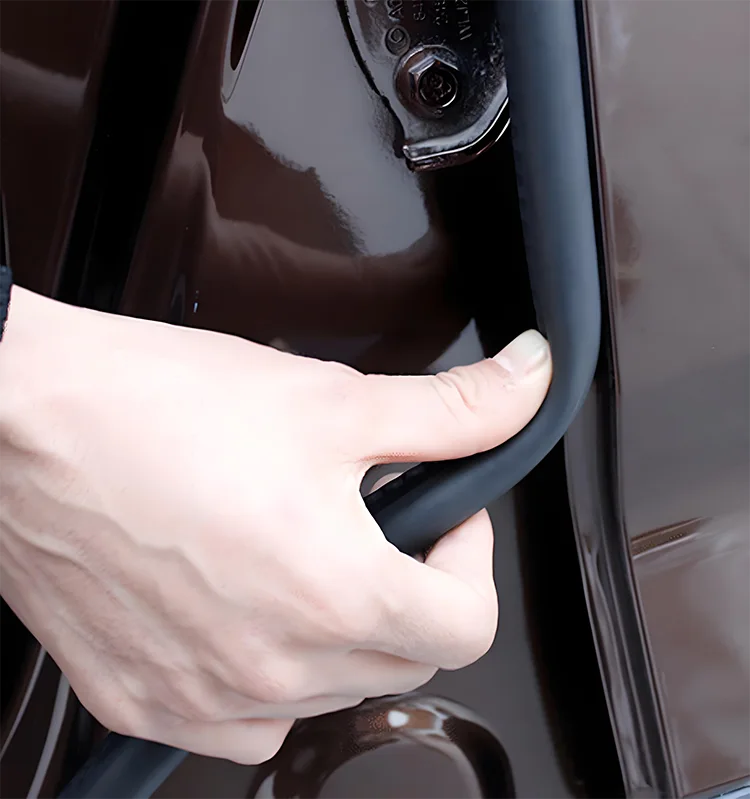
9. Advantages and Disadvantages
From my perspective, metal-framed rubber sealing strips bring a strong balance of performance and durability, but like any component, they have trade-offs that buyers and product managers should consider.
Advantages
- Strong Retention – The embedded metal frame grips flanges securely, maintaining position even under heavy vibration or repeated door/window use.
- Consistent Shape Around Curves – The carrier allows the seal to follow complex contours without collapsing or distorting, ensuring uniform compression.
- Improved Durability in Vibration-Heavy Environments – Ideal for vehicles operating on rough terrain or under constant motion, where non-reinforced seals might loosen.
Disadvantages
- Higher Cost – Compared to non-reinforced rubber seals, the addition of a metal carrier increases material and production costs.
- Potential Corrosion of Metal Frame – Without proper coating or material selection, the metal carrier can rust over time, especially in coastal or salted-road environments.
- Added Weight – While minimal in most applications, the extra mass may be a factor in weight-sensitive designs, particularly in electric or performance vehicles.
Understanding these pros and cons helps ensure the right balance between performance requirements, budget constraints, and long-term maintenance expectations.
10. Testing and Validation
Before I approve any automotive rubber sealing strip with a metal frame for production or delivery, it must pass a series of tests to confirm performance, safety, and durability. These evaluations are essential to ensure the product will meet both OEM requirements and real-world conditions.
Water Leak and Wind Noise Tests
Seals are installed on test vehicles or rigs and subjected to high-pressure water sprays and simulated driving wind to check for leaks and noise intrusion. This confirms sealing integrity under harsh weather.
Salt Spray and Corrosion Tests for Metal Frames
The metal carrier is exposed to ASTM B117 salt spray conditions to evaluate corrosion resistance. This is critical for vehicles operating in coastal or winter road environments.
Ozone and UV Aging Tests for Rubber
Samples are placed in controlled chambers with high ozone concentration or intense UV light to replicate years of outdoor exposure. This ensures the rubber won’t crack, fade, or lose elasticity prematurely.
Compression Set and Resilience Tests
The sealing bulb is compressed for a set duration and temperature, then measured for its ability to return to its original shape. This helps predict long-term sealing performance after repeated door or window operation.
Window Run-Up Force for Glass Runs
For seals used in window channels, force gauges measure the effort required for the glass to move up and down. This ensures smooth operation while maintaining adequate sealing pressure.
By adhering to these validation steps, I can confidently assure that the sealing strips will perform reliably across the entire vehicle lifecycle, even in the most challenging operating conditions.
11. Applications in Automotive Design
In automotive design, metal-framed rubber sealing strips are a versatile solution that can be adapted to many vehicle types and configurations. I’ve seen them used successfully across a wide range of models and environments.
Passenger Vehicles
In sedans, SUVs, and hatchbacks, these seals are found along door perimeters, trunk lids, hoods, and window channels. Their role is to maintain cabin comfort by blocking external noise and weather while also protecting the body structure from corrosion.
Commercial and Specialty Vehicles
Buses, delivery vans, and refrigerated trucks often use reinforced seals for their large sliding or hinged doors. The strong grip and shape retention of the metal carrier help these heavy doors seal tightly despite frequent use.
Case Study: Sliding Door Seals in Vans
One project I worked on involved supplying custom glass-run and edge-trim seals for a fleet of commercial vans. The vehicles were used in a coastal city with high humidity and salt exposure. We chose stainless steel U-shaped grooves to enhance corrosion resistance and EPDM sponge bulbs for consistent compression. After two years in service, the seals showed minimal wear, no rusting, and maintained smooth door operation—demonstrating the value of material selection and proper design.
Whether for daily commuters, rugged off-roaders, or high-use commercial fleets, these sealing strips provide the reliability, comfort, and durability that modern automotive designs demand.
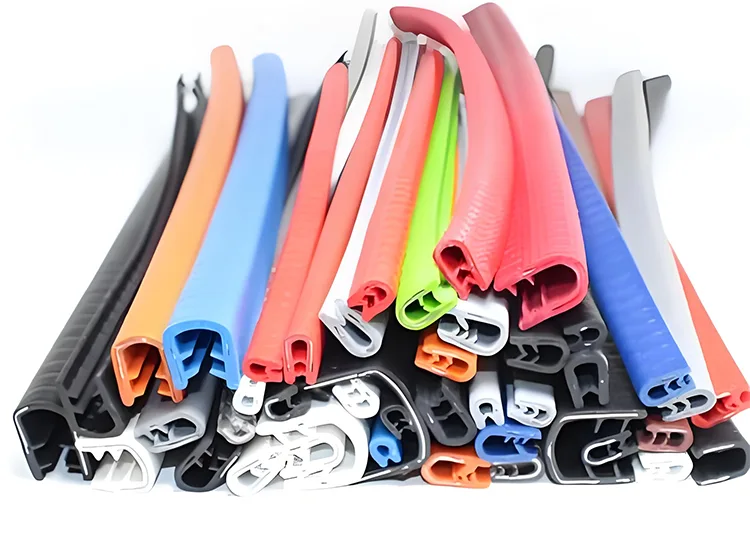
12. Conclusion
From my experience, automotive rubber sealing strips with metal frames are far more than simple trim pieces—they are precision-engineered components that directly influence a vehicle’s comfort, safety, and service life. By combining the flexibility and sealing power of high-quality elastomers with the structural strength of a metal carrier, they deliver consistent performance in even the most demanding environments.
Their role extends beyond keeping out water and dust; they reduce noise, protect bodywork, and maintain the integrity of moving parts like windows and sliding doors. When designed with the right materials, manufactured to strict standards, and tested for real-world conditions, these seals can last for years without losing their effectiveness.
For buyers, product managers, and engineers, proper specification and sourcing of these components is essential. Choosing a trusted manufacturer that understands both the technical and environmental demands of the application ensures the final product delivers on its promise—sealing with strength, precision, and reliability.
References
- SAE International – SAE J200 Classification System for Rubber Materials
Related Articles
EPDM Sealing Strip Types & How to Choose the Right One?
Delve into the different types of EPDM sealing strips—including metal-clip reinforced variants—and understand how to select designs based on attachment requirements, compression behavior, and environmental resistance.
Co-Extrusion Sealing Strips: Technology & Applications
Learn about the co-extrusion process that combines rubber material and embedded carriers (metal or otherwise) into a unified seal—critical for understanding how structural strength and sealing flexibility are achieved simultaneously.
Which Materials Are Suitable for UV-Resistant Seals?
Explore the material choices like EPDM and silicone, highlighting their performance under UV exposure and harsh climates—an essential consideration for automotive seals exposed to sun and outdoor elements.

